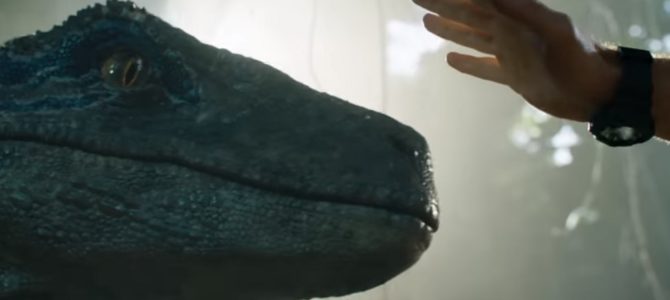
Since the feathered dinosaur revolution of the last couple decades, every time a dinosaur movie comes out it hatches think pieces about how the film is trampling on science. This will continue until Hollywood acquiesces and finally turns these bygone monsters into birds.
As part of the press surrounding the latest Jurassic Park film, paleontologist Jack Horner was recently featured on KPCC’s “The Frame” to discuss his advisory role on the biggest dino franchise of them all. He’s been there pretty much since the beginning, and now he’s claiming that they knew back in 1992 and ‘93 that velociraptors had feathers. According to him, the reason that they weren’t designed like this for the first film is that the constraints of CGI made it impossible.
I’m a huge Jurassic Park fan and dino nerd, and I have never heard this excuse for why the velociraptors were not depicted as feathered back in 1993. It’s almost certainly true that early-90s CGI wouldn’t have been able to handle feathers on the dinos. They were pushing the limits of technology as it was.
But Horner’s claim that “We knew at that time that dinosaurs, that some dinosaurs, especially the raptors, had feathers” looks to be false. That’s especially because in this brief NPR segment Horner maintained that, aside from the feathers, the movie’s creators depicted the dinosaurs as accurately as they could based on the theories of the day.
That claim should meet immediate incredulity, because there were a lot of paleontological problems with Jurassic Park by the standards of its own time. Here are the three big ones.
1. T-Rexes Can’t See Prey If It Holds Still?
The idea that Tyrannosaurus Rexes could not see prey if they remained still is not only absurd but, as far as I can tell, was never even a real theory. Michael Crichton is partly to blame, because he has protagonist Dr. Alan Grant speculate that the motion of rain would impair a T-Rex’s vision. In “The Lost World” (1995), he actually addresses the nutty motion theory “Jurassic Park” created by attributing it to a villainous scientist that T-Rexes kill while he’s standing still.
Crichton meticulously researched what he wrote about, giving his novels a lot of credibility, especially when he did take artistic liberties. He didn’t always get everything right, even by the standards of the day, but he never went this wrong.
2. Inaccuracies About Dilophosauruses
Dilophosaurus did not have a frill, and full grown would have been about eight feet taller than the tiny predator that kills Dennis Nedry in “Jurassic Park.” There’s also no evidence that they were venomous. In the novel, Crichton added the venomous spitting part partially to make the animal more menacing, since it’s believed Dilo jaws were too delicate to be used for killing. He also did so to highlight the folly of messing with things we don’t understand. Their ability to spit poison delayed the river cruise ride because it was simply too dangerous.
3. The Jurassic Park Velociraptors Are All Wrong
The Jurassic Park velociraptors simply are not velociraptors. In the original film and novel, they were radically different from conventional thought about Drameosaurs (their subgroup is popularly known as raptors thanks to “Jurassic Park”) at that time. The actual Velociraptor Mongolenis are about as large as a medium-sized dog.
But early in the first novel, Crichton has Grant identifying a fossil found in North America as belonging to Velociraptor Antirrhopus, which is actually a taxonomic confusion of Deinonychus antirrhopus. This is a very different species from V. Mongolenis but is still in the “raptor” family. This seems to be the dino on which Crichton and the filmmakers primarily based their physical designs.
It turns out they all liked the name Velociraptor better, because it is better. But D. Antirrhopus is really only twice the size of V. Mongolenis in real life. So that’s like upping the ante from a beagle to a Great Shepherd.
The raptors in the Jurassic Park franchise have always been officially marked at six feet tall. That’s at least twice the size of D. Antirrhopus. In the end, it’s just artistic license, right? Yet after they went into production on the first film, Utahraptor was discovered in real life, and it basically matched the massive dimensions of Jurassic Park’s horrifying raptors and then some. Since then, several more “giant” raptor species have been discovered: Achillobator, Austroraptor, and Dakotaraptor.
So either Horner was ignorant of the actual science of the day, he virtually had no input, or he just didn’t try very hard. Most likely, he had little input. Films have never cared that much about reality. Whatever the case may be, he simply isn’t telling the truth when he says they were accurate except for the feathers.
More importantly, the idea that raptors had feathers wasn’t popularized until much later. According to National Geographic, “Three years after the first Jurassic Park debuted, paleontologists announced that the small theropod Sinosauropteryx was covered in a fine coat of fuzzy protofeathers. This was just the initial drop in a flood of feathery dinosaur discoveries which confirmed that a wide variety of dinosaurs bore archaic forms of plumage, from simple filaments to asymmetrical feathers that would have allowed them to fly.”
Here the plot thickens. Horner is not only wrong about whether they “knew” raptors had feathers in the early ‘90s, he actually fibbed about why they didn’t put feathers on the movie’s dinosaurs. He claims it was due to the constraints of CGI at the time. But if you go through all the production artwork and all the documentaries and extras about “Jurassic Park,” you will not find one instance where this is depicted or even discussed. That’s because it simply wasn’t a thing yet.
This isn’t the first time Horner has been wrong about his opinions concerning the Jurassic Park franchise. According to the Smithsonian:
Could it be that Crichton used some artistic license to beef up the true Velociraptors, little predators from the Cretaceous of Mongolia? It is possible, but I doubt it, particularly given the statements of one of the film’s scientific advisors. DVDs are packed full of special features, including ‘making of’ films, and in one of these documentaries accompanying the Jurassic Park III feature, paleontologist Jack Horner states that it has only been recently that any good skulls of Velociraptor have come to light. This is incorrect, as one of the fossils to which the name Velociraptor was first assigned was a beautiful skull. In fact, it is reconstructions of the skull of Deinonychus that have changed because of recently discovered material. Perhaps the more popular name was kept so not to confuse viewers.
Clearly that is exactly what happened. Aside from being part of the inspiration for the Grant character, one has to wonder exactly what Horner does or did as an advisor on these films. He certainly has not held them accountable for what he deems to be the dogmatic truth that raptors were feathered, or really it seems any facts concerning dinosaurs.
On “The Frame,” he said “The Jurassic Park movies, you know, really are—it’s a story right from the very beginning, so you can’t really change those dinosaurs the way they look anywhere in the film. But now days we know dinosaurs looked very different.”
So one of the scientific advisors on Jurassic Park is making an apology for what he considers to be bad science in that film. But the apology holds water like a spaghetti strainer. The dinosaurs, most notably the raptors, have been changed in every single film. In the third one, they actually did add some feathers!
The Real Reason Feathers Aren’t for Jurassic Park
Horner actually lets slip the true reason they probably never will—and I think shouldn’t—add feathers to the raptors: “I think the thing that really interests kids and anyone. What dinosaurs actually do for people. First off, they’re gigantic. A T-Rex is 40 feet long. Some of these big sauropods are 100 feet long. They’re just enormous animals, and they’re different than anything that’s alive today. Completely different. There’s no animal alive today that looks like a dinosaur. And they’re gone. They’re just these gigantic imagination engines, especially for little kids.”
He is absolutely right about that. That is why we really don’t want to see a feathered raptor, and why I’m grateful he’s had very little effect on these films. Changes like that kill the imagination engine. When you look at the dinosaur art being done today, it’s remarkably depressing, especially if they’re correct that all the raptors were feathered. Depicting them like that makes them no longer dinosaurs anymore. The great and powerful Oz will have been reduced to a funny little man.
Dinosaurs would then just be birds instead of mysterious monsters, and our collective imagination would be reduced to that annoying kid in the first “Jurassic Park”: “That doesn’t look very scary. More like a six-foot turkey.” Who wants to go to a movie about a six-foot turkey?
Scientific truth is important. The truth is always important. But that doesn’t mean we have to like it.









